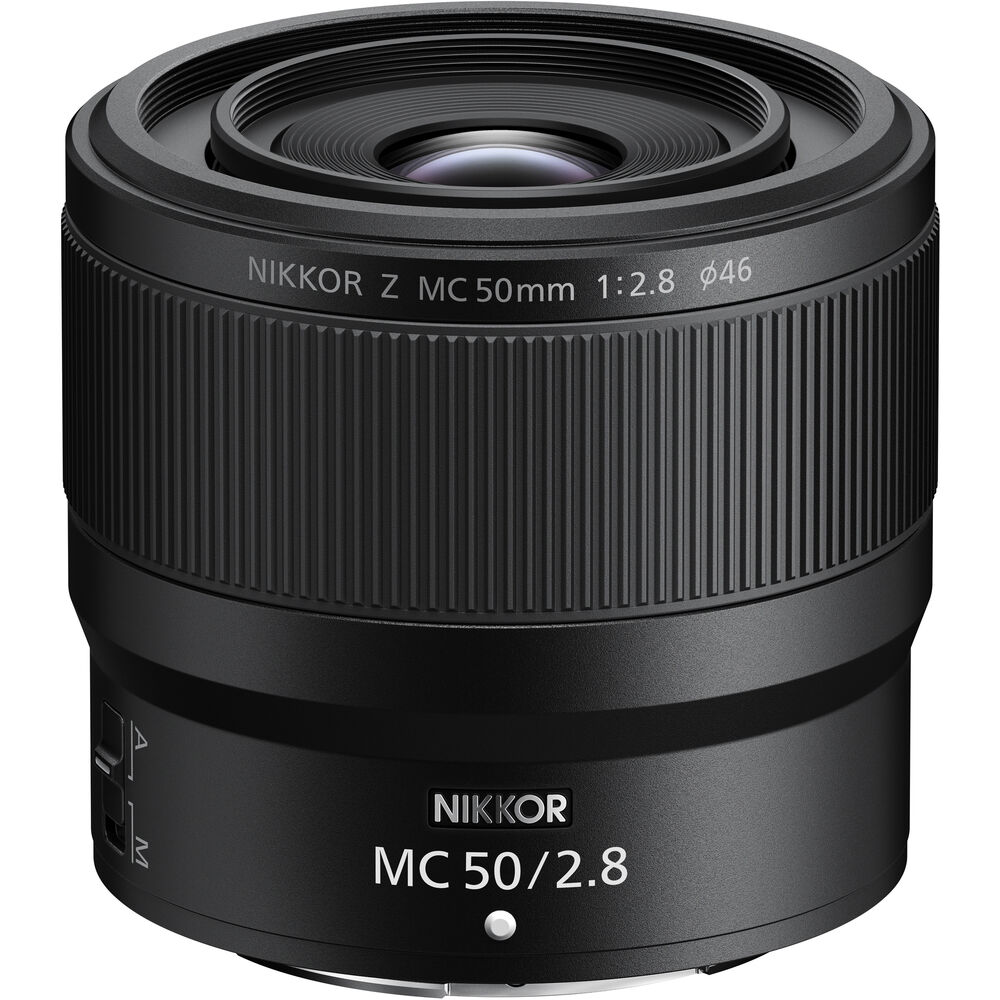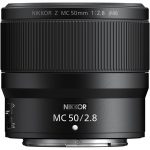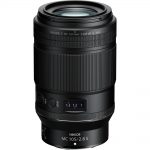Nikon Nikkor Z MC 50mm F/2.8
Macro lens • Digital era
Abbreviations
| Z | The lens is designed for Nikon Z digital mirrorless cameras. |
| MC | Macro lens. Designed specially for shooting close-ups of small subjects but can be also used in other genres of photography, not necessarily requiring focusing at close distances. Learn more |
Features highlight




Specification
| Production details: | |
| Announced: | June 2021 |
| Production status: | ● In production |
| Original name: | Nikon NIKKOR Z MC 50mm 1:2.8 |
| System: | Nikon Z (2018) |
| Optical design: | |
| Focal length: | 50mm |
| Speed: | F/2.8 |
| Maximum format: | 35mm full frame |
| Mount and Flange focal distance: | Nikon Z [16mm] |
| Diagonal angle of view: | 46.8° |
| Lens construction: | 10 elements in 7 groups |
| 1 ASPH, 1 ED | |
| On Nikon Z APS-C [1.53x] cameras: | |
| 35mm equivalent focal length: | 76.5mm (in terms of field of view) |
| 35mm equivalent speed: | F/4.3 (in terms of depth of field) |
| Diagonal angle of view: | 31.6° |
| Diaphragm mechanism: | |
| Diaphragm type: | Automatic |
| Aperture control: | None; the aperture is controlled from the camera |
| Number of blades: | 9 (nine) |
| Focusing: | |
| Closest focusing distance: | 0.16m |
| Magnification ratio: | 1:1 at the closest focusing distance |
| Focusing modes: | Autofocus, manual focus |
| Autofocus motor: | Stepping motor |
| Manual focus control: | Focusing ring |
| Focus mode selector: | A - M |
| Manual focus override in autofocus mode: | Determined by the camera |
| Focusing distance range limiter: | FULL;0.16-0.3 |
| Vibration Reduction (VR): | |
| Built-in VR: | - |
| Physical characteristics: | |
| Weight: | 260g |
| Maximum diameter x Length: | ⌀74.5×66mm |
| Weather sealing: | Dust-proof and water-resistant barrel |
| Fluorine coating: | Front element |
| Accessories: | |
| Filters: | Screw-type 46mm |
| Lens hood: | HN-41 - Screw-type round |
| Teleconverters: | Not compatible |
| Source of data: | |
| Manufacturer's technical data. | |
Manufacturer description #1
June 2, 2021
LOOK CLOSER: NIKON UNVEILS THE NEW NIKKOR Z MC 105mm f/2.8 VR S AND NIKKOR Z MC 50mm f/2.8, THE FIRST NIKON Z SERIES MICRO LENSES FOR MACRO PHOTOGRAPHY
The Powerful NIKKOR Z MC 105mm f/2.8 VR S and the Compact NIKKOR Z MC 50mm f/2.8 Lenses Add Creative Versatility to the Expanding NIKKOR Z Lineup; Nikon also Announces Upcoming Release of Compact Primes in 2021
Melville, NY – Today, Nikon Inc. announced the NIKKOR Z MC 105mm f/2.8 VR S and NIKKOR Z MC 50mm f/2.8, the latest additions to the rapidly growing NIKKOR Z lens lineup for Nikon’s high-performance Z series mirrorless cameras. The premium NIKKOR Z MC 105mm and the compact NIKKOR Z MC 50mm are the first NIKKOR Z lenses to feature a 1:1 reproduction ratio, allowing users to get close to their subjects and fill the frame with edge-to-edge sharpness and incredible details. Whether photographing subtle intricacies of wildlife, wedding details, food and jewelry or capturing striking portraits with gorgeous bokeh, these new macro lenses deliver a fantastic combination of versatility and precision.
“As the first native micro NIKKOR Z lenses, the NIKKOR Z MC 105mm and NIKKOR Z MC 50mm strengthen our expanding Z series lineup, adding yet another category of powerful optics,” said Jay Vannatter, Executive Vice President, Nikon Inc. “Together, both lenses represent a new category for the NIKKOR Z lineup, yet each have their own personalities and advantages that creators are bound to love.”
These new NIKKOR Z lenses benefit from the Nikon Z mount, which features a large diameter and short flange focal distance to deliver superior optical performance and abundant light gathering abilities. The lenses render sharp images from edge-to-edge, suppress chromatic aberrations across the focusing range and virtually eliminate color bleeding and fringing typical of macro lenses. Users of either new lens can also take advantage of the focus peaking feature in the Z series cameras to easily acquire and maintain manual focus for macro shots with incredible depth of field.
NIKKOR Z MC 50mm f/2.8: Wherever You Go, Get Closer
The NIKKOR Z MC 50mm f/2.8 is a small and lightweight micro lens designed for spontaneous street snapshots and capturing small details with stunning clarity. The lens sports a 1:1 reproduction ratio, and an extremely compact and lightweight design of merely 9.2 oz, making it a portable and comfortable option to carry around for all-day shooting.
With a natural 50mm focal length, the NIKKOR Z MC 50mm f/2.8 takes advantage of ambient light to deliver beautiful images with a wider field of view, which is ideal for photographing up-close scenes of food, flowers or everyday snapshots. The 0.53 ft (0.16m) minimum focusing distance enables users to get closer to the action and amplify the separation between the subject, background, and foreground. Meanwhile, the NIKKOR Z MC 50mm’s large f/2.8 aperture affords gorgeous bokeh, fast shutter speeds and superior flexibility for shooting handheld, especially when paired with full-frame Nikon Z series cameras that feature IBIS. Equipped with stepping motors (STM) and a focus limiter switch, the NIKKOR Z MC 50mm delivers fast and reliable autofocus when shooting photos or videos in the field, such as capturing butterflies or the petals of a flower blowing in the wind.
The NIKKOR Z MC 50mm f/2.8 sports a modern design with a variety of intuitive controls, including a lens barrel that integrates helpful visual indicators for focus distance and reproduction ratio. The lens also features a focus limiter switch to limit the AF search range for effortless capture, while the control ring can be assigned to a variety of functions. The lens is augmented with a fluorine coated front element to resist dirt and smudges, as well as a dust and drip resistant build for rugged reliability, making it an ideal travel lens to take everywhere.
Furthermore, the NIKKOR Z MC 50mm is compatible with the ES-2 film digitizing adapter set, which can be screwed onto the front of the lens for digitizing 35mm film, expanding the creativity possibilities of the lens.
Manufacturer description #2
50mm is a natural focal length. Similar to our field of vision, it just feels right in so many situations. The NIKKOR Z MC 50mm f/2.8 brings that just-right feeling to the exciting world of macro. Shoot as close as 0.16m and capture the smallest details at 1x lifesize magnification—ideal for spontaneous snapshots, food photography or exploring the small details of everyday life. Or use it as an an everyday lens to enhance foreground/background separation and selective focus. Compact, lightweight and weather-sealed, it's likely to become one of your most prized and versatile lenses.
Get as close as 0.16m to highlight the smallest details. Exciting new possibilities open at this distance—frame-filling views that reveal hidden textures, shapes and details, all in a natural-feeling 50mm perspective.
NIKKOR Z MC 50mm f/2.8's AF system is optimized for close distances—fast, accurate and virtually silent with suppressed hunting and breathing. Manual adjustments are silky smooth and precise. Flip the Focus Limiter switch and get even more speed and accuracy across a smaller distance range.
The key to transporting your viewer to smaller worlds is 1x lifesize magnification. This 1:1 reproduction ratio creates an effect unique to macro lenses. Use it to draw attention, add drama or accurately reproduce small objects and documents.
Wide open at f/2.8, The NIKKOR Z MC 50mm f/2.8 creates a beautiful soft background blur or bokeh. Create images with dramatic selective focus, background/foreground separation for drawing in your viewer's attention.
The NIKKOR Z MC 50mm f/2.8 is also an outstanding everyday and portrait lens. The combination of its shallow depth of field and 1x lifesize magnification creates a unique, almost three-dimensional, effect in your stills and videos. And its compact, rugged design make it a multipurpose workhorse.
Nikon's unique front-focusing design minimizes the size and weight of the NIKKOR Z MC 50mm f/2.8. This is a wonderful compact, comfortable prime you'll want to leave on your camera.
Getting close to your subject means sometimes accidentally coming in contact with it. When this happens, the NIKKOR Z MC 50mm f/2.8's nonstick Fluorine coating prevents fingerprints, smudges and grime on the front surface. It's also weather sealed against dust, dirt and moisture, so you can confidently take it anywhere.
Nikon uses the largest lens mount of any full-frame mirrorless system. It may seem like a small difference, but it's impact is huge. More light capture. Sharper details. Better colors. Less distortion. Lighter lenses.
The sweet spot of traditional lenses are often a stop or two from wide open. Not NIKKOR Z lenses. They're just as sharp wide open as they are stopped down.
NIKKOR Z lenses are as sharp at their edges as they are at their centers. Vignetting and light falloff seen in traditional lenses are virtually nonexistent.
NIKKOR Z lenses have conquered many traditional imperfections. The NIKKOR Z MC 50mm f/2.8 uses both Aspherical and Extra-low Dispersion glass elements to virtually eliminate chromatic aberration usually seen in macro close-up shooting.
Unique dust, dirt and moisture repelling coating. Easy to clean.
Shorten the autofocus range for close distances. Faster, more precise performance.
Compact, sturdy design, thanks to a front-focusing system.
Attach the optional ES-2 Film Digitizing Adapter Set to the NIKKOR Z MC 50mm f/2.8 and turn your full-frame Z series camera into a high-resolution film digitizer. Bring 35mm film negatives or slides back to life as stunning digital images.
Manufacturer description #3
Suited for a wide variety of scenes, utilizing the minimum focus distance of 0.16 m, maximum reproduction ratio of 1:1, and standard focal length of 50 mm.
The superior optical performance of the Z mount system enables sharp rendering to the edges of the frame.
Ghost and flare are effectively reduced with the increased design flexibility of the Z mount system.
Balances high resolution from close to far focal distances and beautiful bokeh achieved with the suppression of color bleed and fringing.
Equipped with a control ring to which functions such as aperture or exposure compensation can be assigned.
Adoption of a stepping motor (STM) and a front focusing system, as well as efficient positioning of lens elements, have enabled a total length shorter by 26% and weight lighter by 39% than the existing F mount model.
The display of the reproduction ratio and focus distance information is supported, for confirmation of information at a glance.
Equipped with a focus limiter function that reduces focusing time during close-up shooting by limiting the focus range.
Designed with consideration of dust- and drip-resistant performance. A fluorine coat is adopted for superior anti-fouling performance.
Travellers' choice
- Fast speed (F/2.8)
- Lightweight (260g)
- Dust-proof and water-resistant barrel
- Fluorine coating on front element
From the editor
A very practical lens, well suited for casual shooting or travel photography, thanks to its light weight, compact size, weather-sealed housing and fluorine coating. Besides, it has dual functionality: it is both a true macro lens and a standard prime lens with a fairly good speed of F/2.8. Despite the fact that the lens is not labeled "Pro", it can hardly be called an amateur lens.
Other macro lenses in the Nikon Z system
| ■Nikon Z mount (1) | |||||||||
| Nikon Nikkor Z MC 105mm F/2.8 VR S • ⌀62 • 1:1 @ 0.29m | Pro | 2021 ● | Compare | 1 | 3 | ||||
|
|
|||||||||


